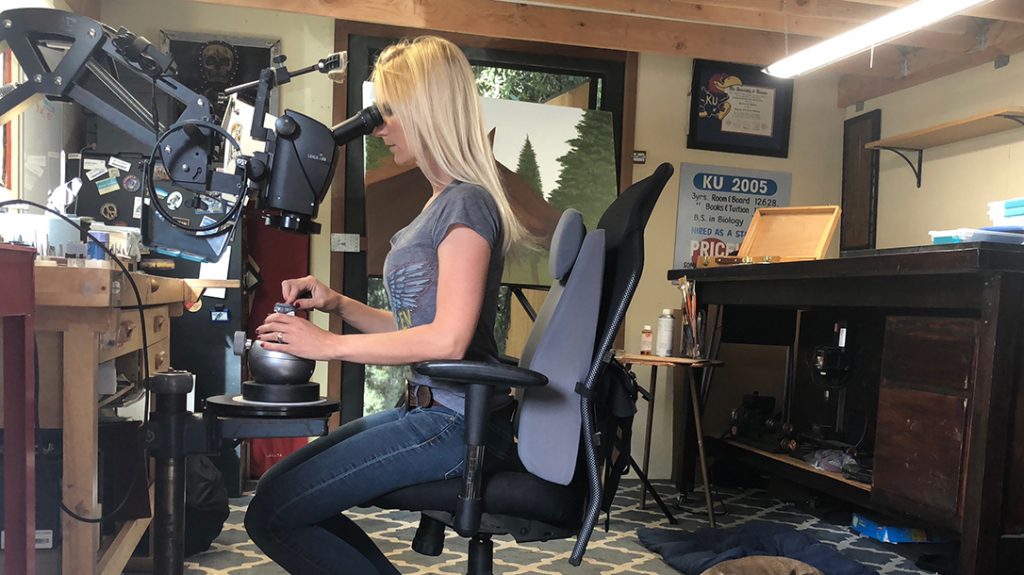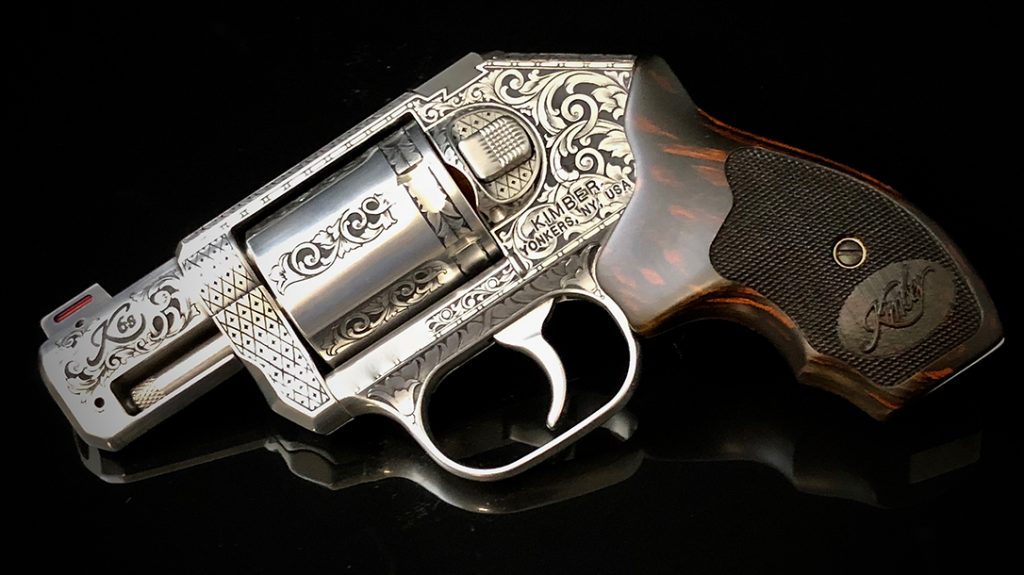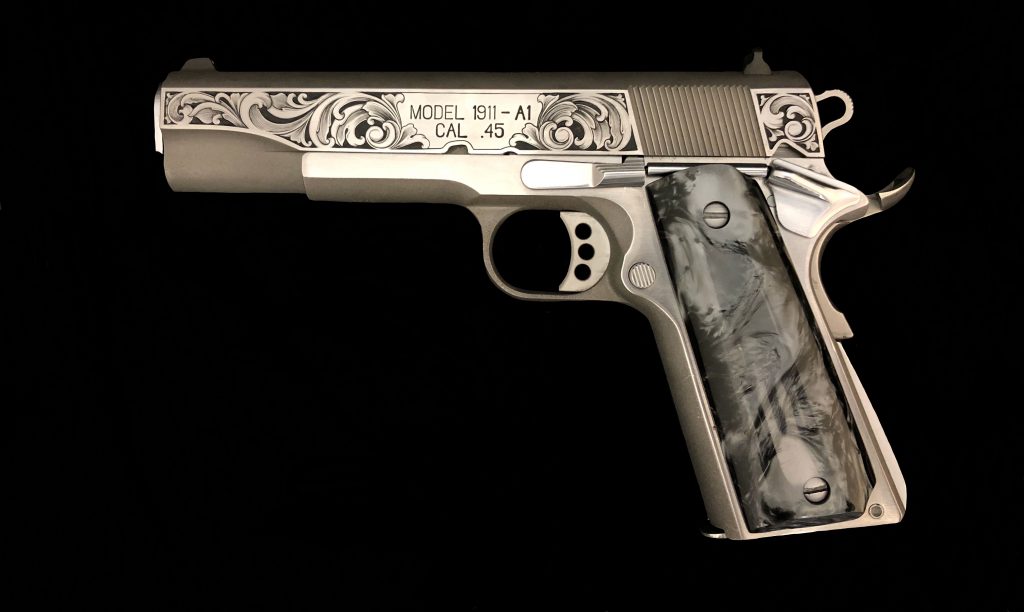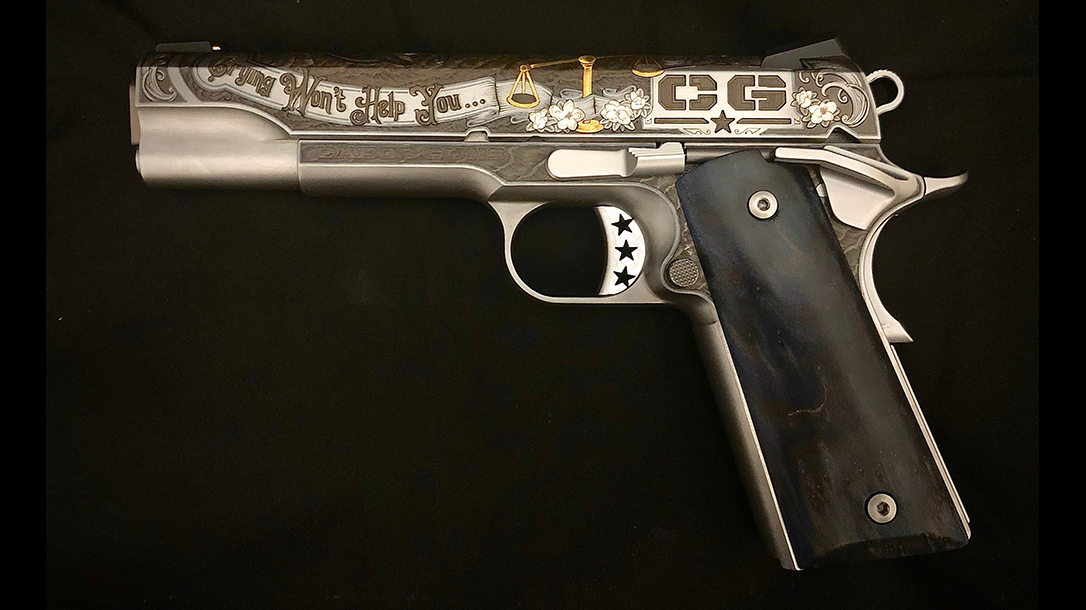They come out like widgets from a press: Black guns almost indistinguishable from one another. They’re highly effective, reliable and functional, yet lack any real visual embellishment that would transform them from tools to art. This has not always been the case, however. There was a day when a person’s firearm was at least in some way modified to make it eye catching. While some see the addition of a paint job or different grips as an attempt to be unique in a pile of snow, it usually falls short. This brings us to gun engraving.
One of the classic methods of really dressing up a gun was engraving. To many, it is a lost art with very few current practitioners. The truth is, however, that the art is still very much alive and thriving in the hands of Melissa McMinn.
Meet the Queen of Gun Engaving: Melissa McMinn
McMinn is an interesting story. With a background in organismal biology and biochemistry, she considers herself a “nerd at heart.”
Advertisement — Continue Reading Below
She shared with me, “Even as a kid, I always gravitated to the arts, sculpting, painting, drawing, as a diversion from the more systematic studies.” She seemed to always be walking on two sides of the line: one in her science world and one in the art world.
“While I was in college, I wrote for a small motorcycle magazine and became enthralled with pinstriping and traditional hot rod arts, such as hand lettering, pinups and flame jobs,” she said. “Once I started painting motorcycles and cars, that led me to move to California, Los Angeles specifically, the epicenter of Kustom Kulture arts, and I worked for Harley Davidson for about a year while painting on the side.”
She ultimately went back into the science world and worked in the biotech industry for 15 years. Even with that career, she never really left her art behind. “During that time, I continued to pinstripe and do leatherwork, and also picked up engraving as a hobbyist, honing my skills nights and weekends,” she said. After she met her now husband, they decided to head to LA again and launch her career as an artist. From LA they headed to Florida, where she now runs her successful business.
Advertisement — Continue Reading Below
The Art of Gun Engraving
To many, including myself, it is a curiosity as to what led her to the art of engraving. “I can’t pinpoint an exact moment or thing, but growing up in Kansas, my father was an avid shooter and I’m guessing at some point through going to shows and gun club meetings with him I saw an engraved gun somewhere and it lodged itself in my subconscious,” she said.

As a gun owner, Melissa said her need to embellish and customize them took hold. Like many of us, she tried her best at self-teaching. However, after a year or two ultimately sought out the help of a master and ended up learning from John Barraclough.
Advertisement — Continue Reading Below
“John and I became great friends and I consider him my biggest mentor in the art,” she said. Melissa prefers metalwork, while still keeping a few other irons in the fire. “I still pinstripe, oil paint, carve and sculpt on occasion, but rarely take commissions, something just for fun. I still do leatherwork on a commission basis, but I’ve limited that significantly, just a project here and there to keep in the mix. Also, I like to have multiple projects going at once so I can vary my workload both mentally and physically.”
Fan Favorite
Of all her work, though, it is her gun engraving that ultimately led me to seek out this interview. More than likely you have seen her work, and it is incredible. One of the first pieces I saw was the “When the Levee Breaks” Cabot 1911. She considers the Cabot gun one of her favorites, and for good reason.
“If I had to choose one (favorite), it would probably be the ‘When the Levee Breaks’ Cabot,” she said. “I’m a huge fan of 1911s, shooting them, the styling and simplicity, and then as a canvas, engraving them. Cabot makes an incredible gun and has done a huge part in elevating firearms into artwork so the canvas itself excited me as well.”
Advertisement — Continue Reading Below
At first sight I was taken with the incredible detail, but wondered about the theme. “I wanted to see a pistol with artwork influenced by the song ‘When the Levee Breaks,’ and I wanted to create it,” she said. “The original song, written by Memphis Minnie and Kansas City Joe McCoy, later popularized by Led Zeppelin, is about the Great Flood of 1927 (Mississippi River). In a nutshell, it conveys that the flood is coming, the levees will break and there’s not much you can do about it if you’re caught in its path.

“The lyrics spoke to me in relation to 2A matters. As in, if you’re forced into a situation where self-defense is your only option, the flood is coming, and you have to act to survive. This is why the ‘levee’ breaks at the front sight, then flood waters rush backward toward the operator, not the other way around.”
Advertisement — Continue Reading Below
Engravers Guild
Her work on that gun earned her the award for best Engraved Handgun of 2020 at the Firearms Engravers Guild of America (FEGA) convention. It was also one of three submissions that earned her the prestigious Master Engraver status. The other two submissions were a Kimber K6 and a Kimber Micro 9. It is also noteworthy to mention that there are only three women designated FEGA Master Engravers, and Melissa earned the title at the youngest age.
I have been in the firearms industry a long time and I have only come across professional engravers a few times. So, I asked Melissa just how many people are still hand engraving?
“I believe there are about 200 members listed with The Firearms Engravers Guild of America, and about 45 FEGA Master Engravers,” she said. “Some of those are full timers, others hobbyists, and some that are not engraving any longer. There are also quite a few engravers out there that are not part of the guild.”
Advertisement — Continue Reading Below
Attention to Detail
Work of this nature is time consuming, to say the least. Along with a workload on items such as knives, jewelry and watches, Melissa does about a dozen firearms a year. And each project is quite extensive.
“It completely depends on the gun and design components,” she said concerning time to complete a project. “Some stainless guns can take up to twice as long as a carbon steel gun because of the difficulty of the metal and constant need to sharpen tools. Inlays, background relief and bulino game scenes are extremely time consuming. Detailing one 0.75-inch animal in photorealism quality can take several long days by itself, sometimes longer.

Advertisement — Continue Reading Below
“Elaborate designs take months to inlay and cut a whole gun, and that’s after the initial time investment in the drawing and design, which can be extensive. It’s a long process any way you look at it. From drawing the design to inlays, cutting, selective finishing, and grips, the ‘Levee Breaks’ took around three months of nearly full-time dedication.”
Lasers vs. Hands
I have seen several guns over the years that had very intricate designs on them. However, something looked almost artificial about them. When I looked deeper, I found that the designs had been made by lasers. While they looked OK, something seemed cold about them.
“Well, as my saying goes, fine hand engraving…because lasers are for spaceships,” Melissa said. “Ha ha…in all seriousness though, if you’ve ever held, touched and really examined a finely hand-engraved gun versus that of a laser engraving, you’ll immediately appreciate the difference. The quality difference of a skilled hand engraver versus a machine is no contest. Laser work has a ‘flatness’ to it. Some of the shallower laser work isn’t truly engraved at all, it’s basically burnt into the surface and can be removed with light sanding and minimal effort. Even deep laser burns cannot polish the walls of their cuts, construct elaborate inlay patterns or add that undeniable human touch to a bulino scene.
Advertisement — Continue Reading Below
“I think lasers are developing their place in our world, but there will always be a niche and desire for traditional hand craftsmanship. There is a romance to it. Knowing I’m creating things that will far, far outlast my lifetime is really rewarding.”
Hand Gun Engraving
People are often stunned at the time and effort that go into gun engraving. In short, people don’t know what they don’t know. So, what are some of the things that Melissa believes people don’t understand about hand engraving?
“I would say the time investment is a huge surprise to people and also the techniques,” she said. “Humans have always had a unique affinity to adorn and customize their possessions, long before the advent of lasers, modern coatings and commodity methods.
“If you look at the history of gun engraving and the manner in which things were engraved, it’s quite remarkable that many of the antique museum-quality pieces you might see were crafted via endless hours of push engraving and hammer and chisel work—methods many of us still use today. I still do all my inlay work with hammer and chisel. I like to be able to feel the chisel undercut the inlay cavities. The stick of the chisel gives me confidence in each cut that my inlays will be tight and secure. You don’t get the same feel with the pneumatic tools, but I do use them for most cutting.”
Like many, I am often taken with the beauty of hand-engraved guns. I’m thrilled that the craft continues in McMinn’s capable hands. For even more info, visit melissamstudios.com.
This article is from the Oct/Nov 2020 issue of Ballistic Magazine. Subscribe today at OutdoorGroupStore.com.






















